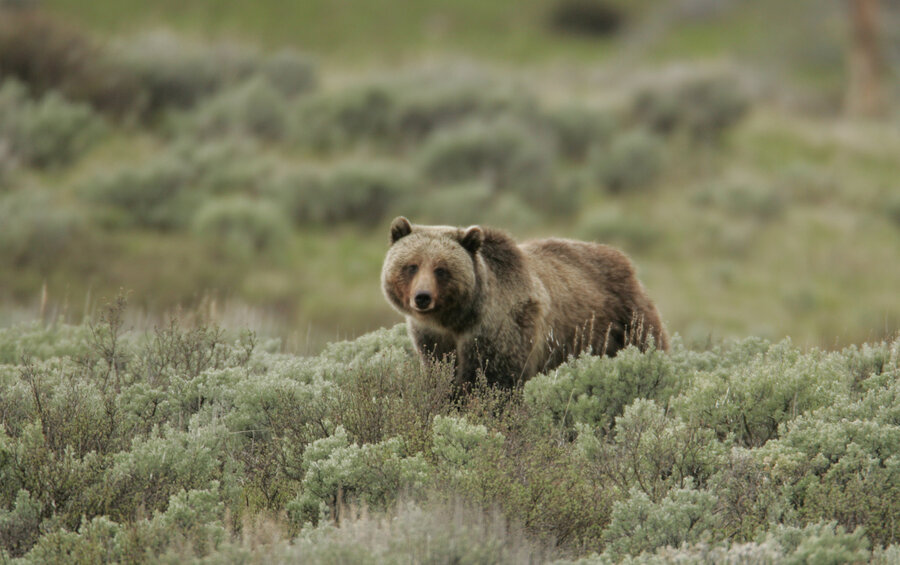Why the return of the wolf is good news for the bear
Loading...
The reintroduction of wolves to Yellowstone National Park has delivered a boon of berries to the area’s grizzly bears, according to new research that highlights the vast ecological reaches of an ecosystem’s top predators.
Researchers at Oregon State University have found that a surge in the wolf population in the northwestern United States over the past 19 years has set off an ecological chain reaction that’s in the end good news for bears: more wolves has cut into elk numbers, thus raising the amount of available berries, thereby providing a juicy supply of food for bears. The new research joins mounting studies pinpointing how a food chain’s top animal – from Spain’s lynx to the Pacific Ocean’s shark – is critical to an ecosystem’s success, emphasizing the importance of programs aimed at protecting some of nature’s most ferocious predators.
“Scientists from all over the world are finding that top predators have strong ecological effects,” says William Ripple, a professor of forest ecosystems at Oregon State University and lead author on the paper, published in the Journal of Animal Ecology. “The top predator can influence the biodiversity of an entire ecosystem.”
The grey wolf, with its confident, yellow-eyed gaze and strong-featured face rimmed in thick hair, has been a focal point of environmentalist debates dating back some 100 years. The drama begins around 1900, when the US government backed sweeping “predator control” programs that tore into the wolf populations in Yellowstone, the geyser-studded park established in 1872 in Wyoming, Montana, and Idaho.
The programs – or, organized hunts – were effective: as of about 1970, all the wolves had been removed from the park. And, in the predator’s absence, other populations exploded: the elk, a massive mammal with antlers fanning like pterodactyl wings, boomed in number.
But in 1995, the US acted on years-in-the-making plans to reintroduce wolves to the park, responding to accumulating evidence that the original program had been shortsighted and that the ecosystem was now reeling from the loss of a keystone species. That endeavor that has been successful enough for the government to this year make the controversial statement that the wolf no longer needs endangered species protection.
In the meantime, scientists have for the last two decades watched the ecosystem change as the wolf populations has surged, measuring the park’s micro-dramas, its subtle adjustments, as it reacquaints itself with a long-lost apex predator.
At the time of the initial reintroduction, the proposal for the program had predicted that the wolves would cut into a animal populations, including elk, as well as bison, moose, and mule deer. The wolf’s competitor, the coyote, would also wane in number.
Still, only now are the full effects of the reintroduction emerging – and, for some of the animals there, the return of the predator has been good news.
“Some of these far reaching effects of the wolves were not expected,” said Ripple. “There was an inkling that the wolf was important to the ecosystem, but it’s only been very recently that scientists are understanding the full importance of top predators.”
To assess how the resurgence in wolves has affected the amount of berries in Yellowstone, Ripple and a team of researchers from Oregon State University drew together a range of factors that together create a broad portrait of ecosystem change. Those factors included a comparison of the percent berry composition of grizzly bear feces to elk population numbers before and after the wolves were reintroduced. The percent berries composition was also correlated with the number of wolves in Yellowstone.
The team found that as the wolf population climbed and the elk population waned, the quantity of the elk’s food source, berries, increased, with some varieties of berries doubling in amount. And as those populations changed, researchers found that the percent berries composition of bear feces climbed – less elk meant more berries, and more berries meant that bears were increasingly using them to fill up.
Wolves, the researchers found, had been a boon to the bear.
And the boons of more wolves don’t end with more berries for bears, says Ripple. Since the wolf was reintroduced, the park has seen renewed growth in trees that elk eat as seedlings, like the willow tree. That growth has bolstered the habitats of several Yellowstone species, including providing more wood for beavers and more nesting space for birds.
“We’re still in the early stages of an ecosystem recovery,” says Ripple.
The new research could have some bearing on how much protection to give the grey wolf, says Ripple. Last month, the US Fish and Wildlife Service announced a plan to phase out the protections that had been aimed to bring the wolf population back to pre-industrial levels. That would make most grey wolves fair game to hunters.
“Policy-makers may want to consider these kind of ecological effects when they set objectives for wolf management,” says Ripple. “If wolf populations are kept at low densities, they may not be ecologically effective.”








